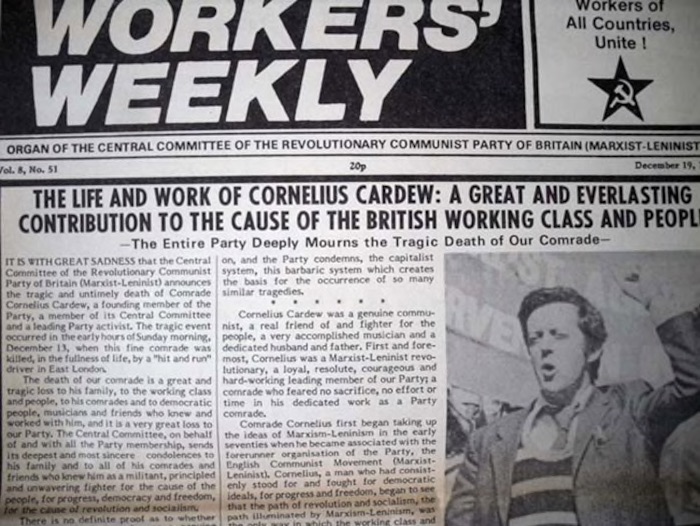![]()
The Complete Cornelius Cardew Treatise at Spectrum
…with Chris McIntyre, Miguel Frasconi, Dan Joseph, David Rothenberg, Nicola Hein, Hans Tammen, Saman Samadi, Melissa Grey, David Morneau, Sarah Manning, Gisburg, Briggan Krauss, Glenn Cornett, Stuart Diamond, Ras Moshe, Laura Feathers, Andrew Drury, Josh Sinton, Giacomo Merega, Joe Hertenstein, David Watson, Sarah Bernstein, David Hyman, Michael Evans, Andrew Neumann, Marcus Cummins, Kurt Ralske, Damien Olsen, David First, Michael Schumacher and Matthew Ostrowski.
Sunday, February 23rd, 2020, 6pm (sharp)
Spectrum
70 Flushing Avenue, Garage A, Brooklyn, New York 11205
[event on facebook]
Pages 1-19: Michael Evans, Andrew Neumann, Marcus Cummins
Pages 20-38: David Rothenberg, Nicola Hein, Hans Tammen
Pages 39-56: Saman Samadi, Melissa Grey, David Morneau
Pages 57-74: Glenn Cornett, David Rothenberg, Stuart Diamond
Pages 75-92: Ras Moshe, Laura Feathers, Andrew Drury
Pages 93-110: Josh Sinton, Giacomo Merega
Pages 111-129: Joe Hertenstein, David Watson, Sarah Bernstein, Michel Schumacher
Pages 130-138: David Hyman Lecture, Hans Tammen
Pages 139-156: Chris McIntyre, Miguel Frasconi, Dan Joseph, David First
Pages 157-174: Sarah Manning, Gisburg, Briggan Krauss
Pages 175-193: Kurt Ralske, Damien Olsen, Matthew Ostrowski
[event on facebook]
Pages 1-19: Michael Evans, Andrew Neumann, Marcus Cummins
Pages 20-38: David Rothenberg, Nicola Hein, Hans Tammen
Pages 39-56: Saman Samadi, Melissa Grey, David Morneau
Pages 57-74: Glenn Cornett, David Rothenberg, Stuart Diamond
Pages 75-92: Ras Moshe, Laura Feathers, Andrew Drury
Pages 93-110: Josh Sinton, Giacomo Merega
Pages 111-129: Joe Hertenstein, David Watson, Sarah Bernstein, Michel Schumacher
Pages 130-138: David Hyman Lecture, Hans Tammen
Pages 139-156: Chris McIntyre, Miguel Frasconi, Dan Joseph, David First
Pages 157-174: Sarah Manning, Gisburg, Briggan Krauss
Pages 175-193: Kurt Ralske, Damien Olsen, Matthew Ostrowski
Cardew, Feb 6th, 1963: “A composer who hears sounds will try to find a notation for sounds. One who has ideas with find one that expresses his ideas, leaving their interpretation free, in confidence that his ideas have been accurately and concisely notated.”
In 2002, while we were on tour in Europe, Keith Rowe showed us the score of Cornelius Cardew’s Treatise, maybe the largest-scale graphic notation ever written. Not sure why it escaped me until then, as it is a stunningly beautiful and unique work of art. It was written over 50 years ago, consisting of 193 pages of elaborate shapes, forms, lines, numbers, and even the occasional musical symbol. Put all the pages on the floor in order (or check out some of the visualizations on YouTube), and the overall structure becomes apparent, revealing transitions and shifts between sections.
Cardew does not tell you how to interpret the pages, there is no indication for pitch, timbre, dynamics, etc.; Treatise is not written for specific instruments, and doesn’t tell you how long you have to play. Pages can be played individually (I often have my students interpret a single page), or as sections (there are many examples of artists interpreting a number of subsequent pages on YouTube). Due to the sheer number of pages, presenting the entire score isn’t happening often.
Cardew himself later disavowed his work, and felt that it gave the composer too little influence over the musical outcome. But as every serious performer of graphic scores knows, lines and shapes can have meaning if you work on it, and one can see the composer’s influence in the overall structure of, and relationship between the elements.

Cardew, June 14th, 1963: “Visual communications. How to develop a visual presentation through logic. How to show continuity in a diagram; in a series of stages, or by reading left to right, etc. In Treatise, the same problem: Which lines are happening continuously, and which are instantaneous events; where to set the borderline? This should be solved. Otherwise work lapses into constant evasions. If one interpretation proves trouble - some or unsatisfactory we slip into another; but this must be watched and conscious.”
This performance is the next iteration of my Anniversary Series at Spectrum, after “In-A-Gadda-Da-Vida Theme and Variations” 2014, “100th Anniversary of Dada” 2016 and “50th Anniversary of HAIR” 2018. We will present the entire score in about 3hrs, using a changing cast of approx. 40 performers. The score is projected on the wall, so you know where we are. Prof. Dr. David Hyman will deliver a lecture as in the past.
[Hans Tammen]

C
Cardew became increasingly politically active outside of music circles, and became a founding member of the Revolutionary Communist Party of Britain (Marxist-Leninist), using the codename “Ernest”. While his works from that period were written in a post-romantic style (he took up “the socialist realist method of composition“, says an obituary by his party), one of his album’s liner notes state that “In hindsight it is clear that in this phase of Cardew's work he was helping open the door to the ‘New Tonality,’ a style enthusiastically endorsed, though individually modified by the English composers who followed him -- Skempton, Parsons, Michael Nyman, Gavin Bryars, Brian Eno, Christopher Hobbs, and others. Cardew did not live to witness the success of this final contribution to English post-modernism; estranged from most of his colleagues and under scrutiny owing to his political convictions, Cardew was crossing a street in London when he was killed in a hit-and-run accident at age 45.”
Hans Tammen likes to set sounds in motion, and then sit back to watch the movements unfold. Using textures, timbre and dynamics as primary elements, his music is continuously shifting, with different layers floating into the foreground while others disappear. His main projects are the hybrid interactive guitar/software instrument Endangered Guitar, the Third Eye Chamber Orchestra, and the all-electronic Dark Circuits Orchestra. His music flows like clockwork, “transforming a sequence of instrumental gestures into a wide territory of semi-hostile discontinuity; percussive, droning, intricately colorful, or simply blowing your socks off” (Touching Extremes). At Spectrum he has curated the “Dark Circuits Series” from 2014-2016, and the “Anniversary Series” since 2014.
